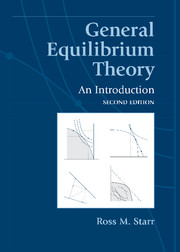Book contents
- Frontmatter
- Contents
- List of illustrations
- Introduction to the second edition
- Preface to the second edition
- Preface to the first edition
- Table of notation
- Table of assumptions
- A General equilibrium theory: Getting acquainted
- B Mathematics
- C An economy with bounded production technology and supply and demand functions
- D An economy with unbounded production technology and supply and demand functions
- E Welfare economics and the scope of markets
- 19 Pareto efficiency and competitive equilibrium
- 20 Time and uncertainty: Futures markets
- F Bargaining and equilibrium: The core
- G An economy with supply and demand correspondences
- H Standing on the shoulders of giants
- Bibliography
- Index
19 - Pareto efficiency and competitive equilibrium
from E - Welfare economics and the scope of markets
Published online by Cambridge University Press: 05 June 2012
- Frontmatter
- Contents
- List of illustrations
- Introduction to the second edition
- Preface to the second edition
- Preface to the first edition
- Table of notation
- Table of assumptions
- A General equilibrium theory: Getting acquainted
- B Mathematics
- C An economy with bounded production technology and supply and demand functions
- D An economy with unbounded production technology and supply and demand functions
- E Welfare economics and the scope of markets
- 19 Pareto efficiency and competitive equilibrium
- 20 Time and uncertainty: Futures markets
- F Bargaining and equilibrium: The core
- G An economy with supply and demand correspondences
- H Standing on the shoulders of giants
- Bibliography
- Index
Summary
Pareto efficiency
The purpose of economic activity is to allocate scarce resources to promote the welfare of households in their consumption of goods and services. There is a very large number of possible allocations of resources (typically, an uncountable infinity), but most of them are wasteful – we can do better. Some wasteful allocations are those that do not make effective use of productive resources (corresponding to points inside the production frontier in the Robinson Crusoe economy). An alternative form of inefficiency occurs in allocations that allocate the mix of outputs among consumers without equating marginal rates of substitution (subject to boundary conditions), leaving room for improvement in the mix of consumption across households (wasteful points corresponding to those off the locus of tangencies in the Edgeworth box).
Economic theory does not give us precise guidance as to the desirable distribution of income and wealth across households. The theory is agnostic on the distribution of income between Smith and Jones and between Rockefeller and Micawber. We are led then to posit a criterion of nonwastefulness as a standard for the effective utilization of scarce resources, while avoiding the moral question of the desirable distribution of income. The nonwastefulness criterion is Pareto efficiency, and it is fundamentally a simple idea. A (Pareto) improvement in allocation is a reallocation that increases some household's utility (moves higher in the preference quasi-ordering) while reducing no household's utility. An allocation is Pareto efficient if there is no further room among attainable allocations for (Pareto) improvement.
- Type
- Chapter
- Information
- General Equilibrium TheoryAn Introduction, pp. 205 - 224Publisher: Cambridge University PressPrint publication year: 2011



